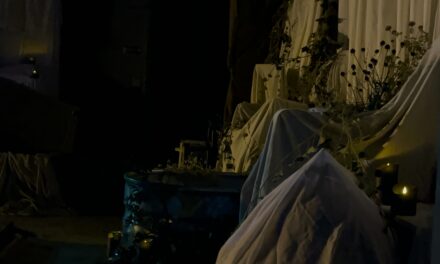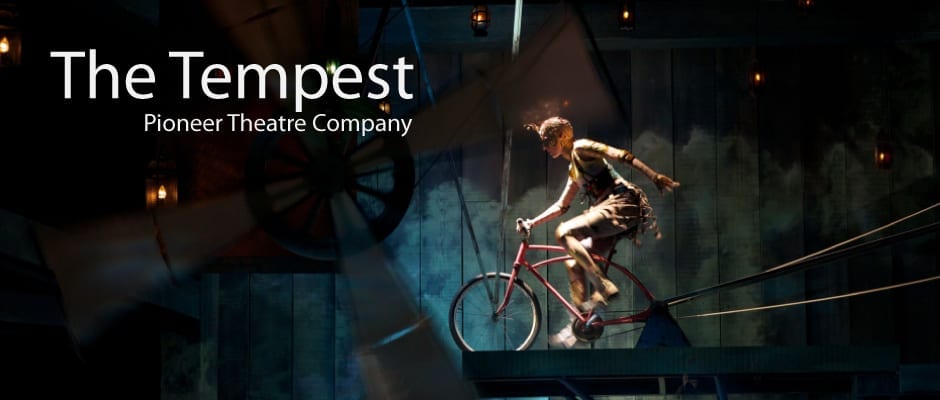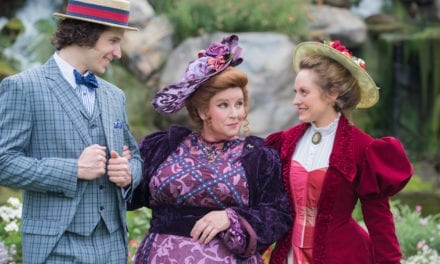
Deanna Ott (left) as Zaneeta Shinn and Rhett Guter as Tommy Djilas in the Utah Shakespeare Festival’s 2011 production of The Music Man. (Photo by Karl Hugh. Copyright Utah Shakespeare Festival 2011.)
CEDAR CITY — The Music Man is a staple of the American theatre. Debuting on Broadway 54 years ago, this beloved show has been produced thousands of times, been incarnated on film (in 1962) and TV (in 2003), and revived on Broadway twice (in 1980 and 2000). As part of the 50th season of the Utah Shakespeare Festival, this classic is being mounted in southern Utah for local audiences.
In addition to the show’s general history, I have a personal history with The Music Man. It was the first play I ever acted in (in 1999) and it was the first full musical that I was music director for (in 2005). So, for me, watching The Music Man is like visiting an old friend with whom you can reminisce. It brings back memories of experiencing the magic of theatre for the first time. Similarly, Meredith Willson’s script is nostalgic. The man grew up in a small town in Iowa and infused the characters with traits and personalities of people that he knew in his childhood. Moreover, a large portion of Willson’s audience in 1957 would have also been children in pre-World War I America and felt nostalgic upon seeing the show, just as I do. Therefore, I have no qualms with approaching The Music Man with a conscious awareness that the musical holds a special place in my heart.
Director Jeremy Mann has a difficult task with this production: how to keep a 54-year-old musical fresh for a 21st century audience. One way in which Mann has succeeded in this task is to help us delve into the psychology of the two main characters: Harold Hill (Brian Vaughn) and Marian Paroo (Laura Griffith). Mann helps us understand these characters in a variety of ways, one of the most effective is to take his time on the spoken scenes between the two where their relationship grows. In fact, the scene in Act II where Marian has just heard about Harold’s possibly seedy past and Harold comes to her home to call was a tour de force of emotion and should put to rest any talk that musical comedies as a genre have shallow characters. Mann also gives the audience hints about Marian’s growing emotions for Harold during the song “Marian the Librarian” (with the help of lighting designed by Jaymi Lee Smith) and at the end of Act I when she sees Winthrop’s excitement over his new coronet.
Rhett Guter‘s choreography also helps this production seem new and exciting. Fused with more ballet than you usually see in The Music Man, the choreography ranges from romantic to athletic, with never a dull moment to behold. Moreover, the choreography contributes vitally the central messages of the play: the power of music to move people. As I saw the music and the excitement that Harold Hill brings to River City move the ensemble characters to dance, it became easier to watch how music was emotionally moving Marian, Mrs. Paroo, Mrs. Shinn, and the other characters. As for specific dance numbers, I was hugely impressed by “Marian the Librarian,” “Seventy-Six Trombones,” and the classic “Shipoopi.” I found all these songs undeniably enjoyable, mostly thanks to the visual spectacle that came from the dancers.
Of course, the best direction and choreography do a production of The Music Man no good if the actor playing Harold Hill can’t handle the challenge. Thankfully, Brian Vaughn‘s portrayal of Harold Hill was everything a Music Man fan could hope for. He was a consummate salesman who effectively conveyed the years of swindling of Harold’s past through subtle line deliveries and the tone of his voice. This was especially true during “Trouble” when he was convincing the townspeople that the otherwise sleepy River City was in dire moral danger. Vaughn‘s delivery of Harold Hill’s semi-musical monologue felt like it had layers of manipulation and years of practice behind it. Moreover, as Vaughn moved among the townspeople, he often seemed like a one-man ballet: light on his feet and comfortable working the crowd.
I was also impressed by performances from some of the other actors. Laura Griffith avoids the trap of playing Marian the Librarian as a cold-hearted snob when she meets Harold Hill; her Marian isn’t mean as she snubs Harold, she just simply isn’t interested in him. As her emotions grow, Griffith shows Marian come to grips with her emotions, even as they overpower the brain that she usually lets guide her. This was especially apparent as she hears rumors about Harold and as she uncovers her own proof that Harold is a liar. If you don’t mind my saying so, I also greatly enjoyed Carole Healey‘s version of Mrs. Paroo, with her delightful Irish accent and busy body tendencies—especially during “The Piano Lesson.” Other minor characters who won me over included the clueless Mayor Shinn (Max Robinson), Ethel Toffelmier (Bri Sudia), and the flamboyant Mrs. Shinn (Leslie Brott). These characters and others combined to form a dysfunctional town, which was just as engrossing dramatically as a dysfunctional family can be. (After all, what town uses a player piano player for civic celebrations when they have a piano teacher at their disposal?)
Technically, the element that stands out in my mind is the set by Jo Winiarski. The set is spartan and utilitarian, but it has a wonderful charm as it morphs into the town square, the library, the footbridge, the Paroo family porch, and other locales with just a few adjustments. The projections of clouds, stars, and the moon on the backdrop added to the magical mood of many of the production’s scenes and did what all good technical aspects should do: focus the audience’s attention on the story and the message of the play.
Although I greatly enjoyed my Music Man experience, there are a few things that I saw in this preview that I hope will be remedied before the show’s official opening next week. First, some of the harmonizations from the quartet were not completely polished; their pieces mostly being a capella makes musical dissonance in the singing especially noticeable. Second, there was a minor sound problem in getting the piano music to sync up properly with Amaryllis’s cross-hand piece. Finally, the audience’s applause was often cut short by the orchestra or an actor starting the next scene. As an audience member, I want to show the full extent of my approval to the cast and cutting the applause short not only prevents me from doing that, but it often prevents me from hearing lines or the music. Of the problems I’ve mentioned, this one should be the easiest to remedy.
But I enjoyed this production so much that I am going to try to make the trip from Utah County to Cedar City again so that I can see it. Jeremy Mann has truly succeeded in making something old and familiar seem new. You really ought to give The Music Man a try.
Update: Watch UTBA’s video interview of the Utah Shakespeare Festival’s executive director, R. Scott Phillips.

Laura Griffith (left) as Marian Paroo and Brian Vaughn as Harold Hill in the Utah Shakespeare Festival’s 2011 production of The Music Man. (Photo by Karl Hugh. Copyright Utah Shakespeare Festival 2011.)




